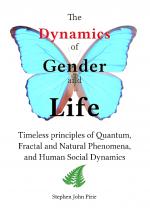by Prof. Amit Goswami (August 13, 2008)
There was a revolution in physics at the beginning of the last century, consisting of the discovery of quantum physics. The message of quantum physics is this: the world is not made of matter neither is it determined entirely by material causation that we sometimes call upward causation because it rises upward from the building blocks of matter–the elementary particles . There is a source of downward causation in the world. You can call this source consciousness if you like and think of it as the ground of all being.
To be sure, the mathematics of quantum physics is deterministic and based on the upward causation model above, but it predicts objects and their movements not as determined events (as in Newtonian physics) but as possibilities (for which the probabilities can be calculated enabling us to develop a very successful predictive science for large number of objects and/or events). And yet when we look at a quantum object, we don’t experience it as a bundle of possibilities, but as actual localized event much like a Newtonian particle. Moreover, quantum mathematics does not allow us to connect the upward causation-based deterministic theory with experimental data. How do the possibilities of the theory become actualities of experience simply by our looking at them? This is the mysterious “observer effect.”
In quantum language, the materialists’ upward causation model translates like this. Possible movements of elementary particle make up possible movements of atoms, make up possible movements of molecules, make up possible movements of cells, make up possible brain states, make up consciousness. Consciousness itself then is a conglomerate of possibilities, called a wave of possibility. How can a wave of possibility collapse another wave of possibility by looking or interacting with it? If you couple possibility with possibility, all you get is a bigger possibility, not actuality.
Suppose you imagine possible influx of money in your bank account. Couple that with all the possible cars that you can imagine. Will this exercise ever actualize a car in your garage?
Face it. For the materialist epiphenomenal model of consciousness, how our looking can change possibility into actuality is a logical paradox.
It stays a paradox until you recognize first, that quantum possibilities are possibilities of consciousness itself which is the ground of all being. And second, that our looking is tantamount to choosing from among the quantum possibilities the one unique facet that becomes our experienced actuality.
We Create Our Own Reality, But . . .
It was in the nineteen seventies that the physicist Fred Alan Wolf created the evocative phrase “we create our own reality.” The images the phrase evoked led, however, to many disappointments. Some people tried to manifest personal automobiles, others vegetable gardens in desert environments, and still others at least a parking space for their cars in busy downtown areas. Everybody was inspired by the theory of quantum creation, no doubt, but the results of their efforts were a mixed bag because they were unaware some subtleties.
We create our own reality, but there is a subtlety in consciousness. We do not create reality in our ordinary state of consciousness, but in a non-ordinary state of consciousness. This becomes clear when you ponder the paradox of Wigner’s friend. Eugene Wigner was the Nobel laureate physicist who first thought of the paradox.
Imagine that Wigner is approaching a quantum traffic light with two possibilities, red and green; at the same time his friend is approaching the same light from the perpendicular road. Being busy Americans, they both choose green. Unfortunately, their choices are contradictory; if both choices materialize at the same time, there would be pandemonium. Obviously, only one of their choices counts, but whose?
After many decades, three physicists at different places and times (Ludwig Bass in Australia, myself at Oregon, and Casey Blood at Rutgers, New Jersey), independently discovered the solution of the paradox: consciousness is one, nonlocal and cosmic, behind the two people’s local individuality. They both choose but from this nonordinary state of one consciousness (which I call the quantum self) where there is no local individuality or selfishness so contradiction can be avoided. This allows the common sense result that in many such crossings, Wigner and his friend each would get green fifty percent of the time; yet for any individual crossing, a creative opportunity for getting green is left open for each.
A key point is that quantum downward causation of choice is discontinuously exerted (if it were continuous, a mathematical model could be constructed for it and the choice would be predictable and not free), but our ordinary state of consciousness smoothes out the discontinuity. To be aware that we choose is to wake up to the non-ordinary oneness taking a discontinuous leap, call it a quantum leap. In this way, the dictum of the new physics: I choose, therefore I am (my cosmic quantum self).
So the new paradigm of reality based on the rediscovery of consciousness within science is not only giving us back our free will, but also is identifying the source of that free will as the spirit within us, the oneness that spiritual and healing traditions have always propounded. The new paradigm is showing us great promise for integrating science and spirit. It is also promising a breakthrough integral approach to medicine that integrates conventional and alternative medicine. Read my book, The Quantum Doctor, for the latest development on this.
 "The Dynamics of Gender and Life" ebook is now available at
"The Dynamics of Gender and Life" ebook is now available at